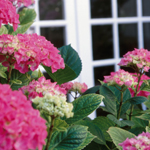The Wonderful Window Box: Design Basics for this Garden Treasure


 More than just a box beneath a window for planting flowers, window boxes actually encompass all garden containers that are horizontal. Incorporating this shape in an area where round pots reign can really make a statement. Deciding where and how you plan to use these containers will help you determine which type to select. Window boxes are available in a variety of materials including wood, aluminum, iron, copper, fiberglass, cement, terra cotta, stone and plastic. Styles also vary, with many designed for specific use.
More than just a box beneath a window for planting flowers, window boxes actually encompass all garden containers that are horizontal. Incorporating this shape in an area where round pots reign can really make a statement. Deciding where and how you plan to use these containers will help you determine which type to select. Window boxes are available in a variety of materials including wood, aluminum, iron, copper, fiberglass, cement, terra cotta, stone and plastic. Styles also vary, with many designed for specific use.
Consider the popular deck railing and look to a wooden box designed to straddle one or both sides. French-inspired metal styles work well on balconies. Wall mounts, or those beneath windows, might be wood, plastic, aluminum or copper. Hayracks have been repurposed to function as window boxes. These new designs are metal, similar to the fancy iron types, but less decorative. Open metal styles like these require a lining, either coconut fiber or a thick layer of moss. Keeping in mind that soil and water add tremendous weight to a window box, installation techniques, brackets and hardware are critical factors and usually require professional assistance. The heavier materials like stone, terra cotta and fiberglass are best on flat surfaces like porches, retaining walls, pathways and steps.
Planting in a window box follows the same basics as other kinds of container gardening. Soil should contain enough organic material to absorb and hold moisture. Add small bark to the soil to improve drainage, and be certain your window box has drainage holes. Lightweight containers have markings on the bottom for punching out or drilling holes. If a window box liner is used (a plastic or metal container that is inserted in the box), both the liner and box will need drainage holes. Fill the planter half-full with soil. Add the plants, working from front and center to the back alternating from side to side. With each plant placed, fill in around the root ball with soil, making sure that the tops of the roots are just below the soil surface. Water the planting until the soil settles, adding more soil to fill the container several inches below the top. Sprinkle a light top dressing of slow-release fertilizer (like Osmocote), and mulch or moss the finished planting.
Keeping your plantings lush and healthy involves a bit of care, and watering techniques are vital. How often and how much water the planting will need throughout a growing season depends on light, location, weather and the type of plants. As plants grow, the soil becomes more inhabited with roots, and water retention is compromised. More frequent watering is required and water soluble fertilizer is recommended with each watering. This recommendation is often met with surprise, but most water at this point drains right through the planting, carrying many nutrients with it. Remove spent flowers and yellowing leaves to keep your planting looking its best. Trim leggy trailers severely to encourage lush new growth.
 Design Basics, Color Rules
Design Basics, Color Rules
Once you’ve sorted through the complexities of drainage, soil and growing conditions of your site, window boxes become a design tool for planting options. A stylish approach combines upright, broad and trailing plants, with texture and color as key elements.
Upright plants become the focal point, adding height and a vertical element to the design. Broader-growing plants fill the horizontal aspect of the window box, and trailing plants spill over with interest. Distinctive differences in leaf and blossom shapes and sizes create harmony and touch-me visual texture.
There are a few absolutes about color, and learning to make the most of color with helpful hints from a color wheel keeps it simple, nontechnical and friendly. Single color schemes feature a single plant variety used repetitively, or a single color that combines flowers that are matched perfectly in hue yet different in size, shape and style.
These monochromatic ideas also include planting a range of shades of a single color—yellow, blue, orange, pink, purple or red. Varying shades of a single color become harmonious when planted together.
Classic combinations of complementary colors are opposites on the color wheel, as different as color can get. Red and green, violet and yellow, and blue and orange are pairs of opposite colors that create the most dynamic contrasts. Adjacent colors on the color wheel are called analogous. Reds, yellows and orange are considered warm colors; greens, blues and violets are cool. Intensity is also important: brights together, softer hues together. It takes a bit of practice to understand color families and work with what you’re seeing, but the results are worth the effort.
With a little guidance and a few gardening rules, you’re on your way to discovering the endless variety of plant options and plant combinations for stylish window boxes that enhance your home and garden.
A FEW OF KERRY’S FAVORITES

Aloysia Triphylla (Lemon Verbena)
Sun Tolerant Coleus Hybrids
Seneciao Cineraria (Dusty Miller)
Scented Geraniums
 FILLERS
FILLERS
Begonia, Angel Wing
Euphorbia Hybrid, “Diamond Frost”
Pentas
Scavevola
Calibrachoa Hybrids
 TRAILING PLANTS
TRAILING PLANTS
LantanaIpomoea Batatas (Sweet Potato Vine)
Dichondra Argentea “Silver Falls”
Plectranthus Coleoides
Sun Parasol Mandevillas






